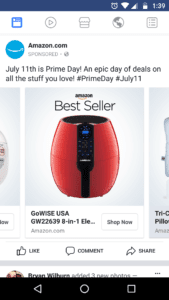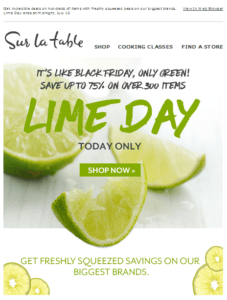Year one, it’s a novelty. Year two—OK, it’s happening again. Year three, it’s a thing, and Amazon.com Inc. has already said there will be a Prime Day next year.
Amazon hasn’t released details and a date for the summer sales event—expect mid-July with spring ramp-ups for merchants that want to participate in the deals—but this year and the two years prior reveal Prime Day sets records for Amazon, drives a double-digit surge in sales and, most importantly, pushes more consumers to sign up for Prime memberships.

Amazon touted this pressure cooker in the run-up to Prime Day.
Amazon introduced the one-day summer sale—it was actually 30 hours this year—in 2015 as a way to celebrate 20 years of selling online. It’s not a groundbreaking idea: Retailers for years have held anniversary sales, Christmas in July promotions, summer clearance events and more. It’s a time for merchants to clear out inventory and catch the attention of consumers who are not yet thinking of the upcoming holiday season.
With Amazon, however, a summer sale takes place on a massive scale. The retail giant set a sales record on Tuesday, July 11, with $2.41 billion in sales, according to Internet Retailer estimates based on data from at least 10 research and analytics firms. Internet Retailer estimates Prime Day 2016 sales at $1.52 billion, which makes for a 58.6% increase year over year. In 2016, Amazon said its Prime Day sales (July 12, also a Tuesday) set a record (later eclipsed by its sales on Cyber Monday). Amazon doesn’t disclose a sales figure for Prime Day or any other specific day, but it says its overall Prime Day sales jumped 60% compared with 2016. Prime Day sales certainly add to Amazon’s growing quarterly sales, but the key purpose of Prime Day, even more than selling a slew of SKUs, is to drive Prime memberships.
And it’s working. Consumers are increasingly signing up for Amazon’s loyalty program that costs $99 a year or $10.99 a month, with reduced rates for students and consumers receiving federal assistance. Prime includes free two-day shipping and offers customers free e-books, video streaming, photo storage and other perks. Estimates from Consumer Intelligence Research Partners as of the end of June peg Prime membership at 85 million in the U.S., up 34.9% from 63 million at the same time in 2016. It also finds Prime customers shop on Amazon nearly twice as frequently (25 times a year) as non-Prime members (14 times) and spend, on average, nearly twice as much per year ($1,300) on Amazon as non-Prime members ($700). CIRP’s data is extrapolated from a survey of 500 U.S. shoppers who bought something on Amazon from April-June.
Amazon offered early deals to Prime customers this year with Prime Day-like deals in the days leading up to July 11. “Amazon has solidified Prime Day as an annual event that shoppers will mark on their calendars—close to nine out of 10 shoppers intend to shop Prime Day in the future,” says Ryne Misso, marketing director at market research firm Market Track LLC.
Amazon is following a known path. Alibaba Group Holding Ltd., which operates the Tmall and Taobao online marketplaces in China and AliExpress outside of China, in 2009 popularized Singles’ Day, which is Nov. 11 (11/11) as a major online shopping day during a slow period on its promotion calendar. Singles’ Day 2016 set a record with nearly $18 billion sold on Alibaba’s marketplaces alone.
China’s largest online retailer, JD.com Inc., offers deals for the first 18 days of June to mark its anniversary, and this year generated 119.9 billion yuan ($17.6 billion) in revenue from the shopping extravaganza held June 1-18. JD doesn’t release sales figures by date for the event but says the number of shoppers who placed orders on June 18 doubled this year compared with last year, and its sales in the first hour of June 18 grew 250% year over year.
Amazon added three countries to this year’s sale—China, India and Mexico—bringing the total to 13. And much of Prime Day’s growth came from outside the United States, according to a Prime Day analysis by One Click Retail, a provider of online retail analytics. For instance, total sales on Prime Day in China exceeded those of Black Friday—another holiday Amazon introduced to China—with many Chinese shoppers purchasing imported products from Amazon’s sites around the world. Perhaps, more importantly to Amazon, the number of Chinese consumers who signed up for Prime in conjunction with the sale was 60% higher than on Black Friday in November 2016.
It’s Amazon’s sale, so it’s no surprise that the web merchant’s own goods were the top sellers on Prime Day. Amazon says it had record sales for Echo devices, Fire tablets and Kindle devices, though it did not release the number of units or sales value. In 2016, Amazon’s Echo, Kindle and Fire TV products accounted for 70% of the top 10 selling products, according to data from Slice Intelligence, which analyzes online sales based on the email receipts of a panel of 4.7 million consumers. “Each of these products, which are marginally profitable for Amazon, become buying platforms for Amazon shoppers for everything from toilet paper to electronic books,” says Ken Cassar, principal analyst, Slice Intelligence.
Amazon placed a heavy emphasis on its Alexa voice-based devices this year, and shoppers responded. Amazon slashed prices 50% on its Amazon Echo voice assistant devices, data from analytics provider Ugam shows. Amazon reported that its Echo Dot—a smaller, hockey puck-like version of the Echo—as its best seller on Prime Day and that overall sales of Echo devices jumped sevenfold compared with this time last year. The Dot, at $34.99 on Prime day compared with its normal $49.99 price tag, was relatively inexpensive compared with the full-size Echo, which sold for $89.99 on July 11 compared with $179.99 regularly.
Amazon also used Alexa-only deals on a small number of items (169) to encourage Alexa users to order through Amazon Echo. Four items included in the Alexa promotions appeared in top 10 most effective promotions
Private-label promotions carried over into apparel as well. The Prime Day fashion deals section featured mostly Amazon brands, and men’s dress shirt brand Buttoned Down has products in the top 20 seller ranking of men’s dress shirts, according to research firm L2 Inc.
Amazon marketplace sellers, which Internet Retailer estimates at 2.5 million, also benefited from the Prime Day halo effect. Sales surged in July, but these merchants’ sales accounted for a lower-than-normal share of goods sold, according to Internet Retailer’s analysis. On a given day, marketplace sellers account for 65% of Amazon sales worldwide, but because the retailer offered many popular deals of its own on Prime Day, marketplace sellers’ share likely declined to about one-third of sales during the July event.
Retail clients of Skubana, a technology vendor with about 1,000 clients that helps retailers and brands sell on marketplaces like those operated by Amazon and eBay Inc., on Prime Day experienced an 80% increase in sales compared with an average day, which was down from 98% a year earlier. This year’s slower growth may stem from Amazon’s intense focus on its own inventory, the company says.
Shoppers, however, found better deals from marketplace sellers, which offered deeper discounts than Amazon’s first-party inventory, according to data from analytics firm Boomerang Commerce. Marketplace sellers offered an average discount of 45%, compared with 35% for products sold directly by Amazon.
It’s not surprising that Amazon products performed well, especially considering the avalanche of emails: Amazon sent more than 1 billion promotional emails to consumers in the run-up to, and on, Prime Day and consumers paid attention.
Amazon sent 68 email campaigns on Prime Day, a 70% jump from the 40 campaigns it sent a year ago, totaling 398 million messages, according to eDataSource, which tracks retailers’ email marketing campaigns. On the day before the sales event, which included six hours of Prime Day sales, Amazon sent 27 campaigns that totaled 335 million messages.
The retailer’s daily average open rates exceeded 20% on all but one day (July 9, a Sunday, averaged 13%), eDataSource finds.
Playing along with Prime paid off. Many retailers that are not Amazon or its marketplace sellers joined the Prime machine, with many launching their own sales or using cheeky Prime tie-ins.

An Internet Retailer analysis of the 100 largest non-Amazon retailers in North America showed that 47 retailers tried to woo shoppers away from Amazon on Prime Day by offering some kind of limited-time sale or pushing out marketing messaging that included the word “prime” that day. Data from Salesforce.com Inc. Commerce Cloud, formerly known as Demandware, found that online sales for non-Amazon retailers increased 44% on Prime Day. Salesforce, which bases its data on an analysis of 500 million online shoppers, made its comparison only for the 24-hour period of July 11 and did not provide year-over-year growth during the six hours of Prime Day selling on July 10.
J.C. Penney Co. Inc.’s Penney Palooza, a two-day sale that coincided with Prime Day, returned for a second year, offering a reduced shipping threshold to $49 from $99, and an additional 30% off for customers who pay with a J.C. Penney credit card.
Sur La Table says it set July 10 as its “Lime Day” sale before knowing Prime Day’s exact data, but the kitchen supply retailer clearly aimed to squeeze some publicity from Amazon by tagging its email promotion “Get Primed for Lime Day.”

The “World’s Most Expensive Jacket” from Betabrand.
Apparel retailer Betabrand took a tongue-in-cheek approach, offering a 99.99% discount on the “World’s Most Expensive Jacket: Affordable At Last” in a July 11 email that began with “Prime Day? Shmime Day!” The reversible smoking jacket “originally priced at $1.96 million” was available for $196.20 for “a very limited time,” according to the email. Betabrand, which has one store, designs, manufactures and sells goods based on beta tests shown to consumers who visit its e-commerce site.
Sales data, web traffic, consumers’ response to Amazon’s Prime-related emails—all these metrics illustrate that Prime Day resonated with consumers. It grabbed their attention and prompted them to spend on a random day in July. The challenge for other retailers is how to best ride that wave of interest in online shopping that Prime Day generates.
Amazon already dominates e-commerce in the United States, and its Prime program and Prime Day are part of its long game to keep the crown and grow its reach globally. The world’s largest online retailer grew its 2016 product sales—or revenue it earned from sales of its products, plus fees it secured for third-party sales on its marketplace—by 24.9% to $123.77 billion globally. That revenue represents nearly 31% of the Internet Retailer 2017 Top 1000 online sales total.
Amazon is leveraging Prime Day to drive Prime memberships and push its own products. In doing so, it’s also building a bulkhead that may be difficult for other retailers to penetrate.
Free Download
10 Ways Retailers can Prepare for Prime Day—Prime Day doesn’t have to be a win just for Amazon. These 10 tips will help Amazon Marketplace sellers and retailers that don’t sell on Amazon get a mid-summer sales boost from the Amazon sales holiday. Download these tips from the 2017 Prime Day Report for free by filling out the form below, or get $50 off your purchase of the complete report using the code 17PRIME50.
